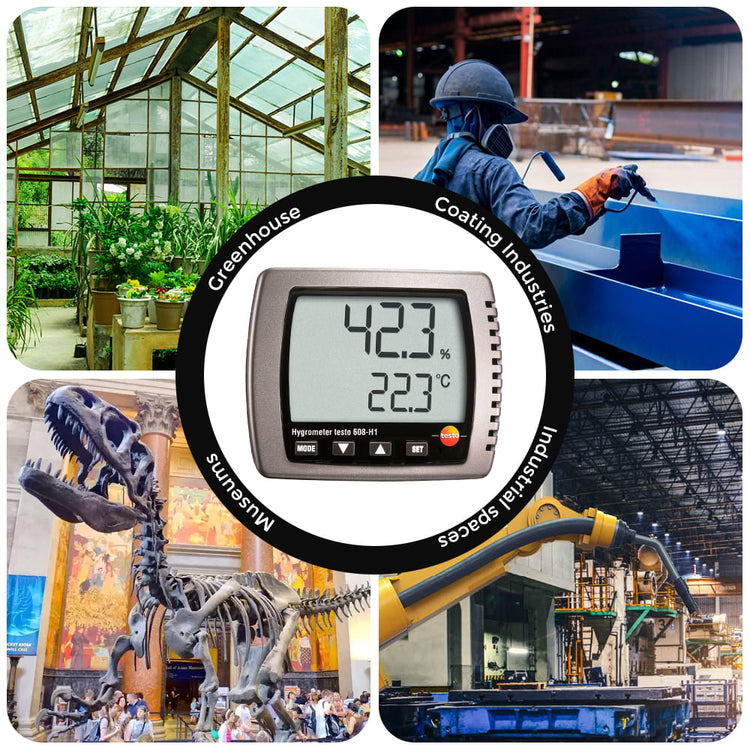
What is a Hygrometer?
The topic of hygrometers centres on their crucial role in monitoring humidity levels. Hygrometers are instruments designed to measure the amount of moisture in the air, also known as humidity. This seemingly modest task holds immense significance, as humidity levels can impact various aspects of our daily lives, including our comfort, health, and the well-being of our surroundings. By providing accurate humidity readings, hygrometers empower us to create optimal indoor environments, prevent moisture-related issues, and make informed decisions about ventilation, heating, and cooling.
These devices offer invaluable insights into local humidity patterns, enabling informed adjustments to indoor environments. By proactively managing humidity levels, individuals can enhance both personal comfort and property preservation, guarding against issues like mould and damage.
The purpose of this blog is twofold: to furnish essential information regarding hygrometers and to conduct comprehensive reviews of the various models currently available.
What Do You Use to Measure Humidity?
A hygrometer is an instrumental device designed to measure humidity levels in the air. Its primary function revolves around quantifying the amount of moisture present in the atmosphere.
Monitoring humidity is of paramount importance for a multitude of reasons. From the perspective of comfort, maintaining an optimal humidity level ensures a pleasant living environment. Humidity significantly influences how we perceive temperature, making balanced levels crucial for avoiding discomfort and promoting well-being. Moreover, proper humidity control holds significant health implications. Too much humidity can foster mould growth and contribute to respiratory issues, while excessively dry air can lead to skin irritations and respiratory discomfort. Humidity management also finds applications in various industries, including agriculture, manufacturing, and storage, where precise moisture control is critical for product quality and preservation.
What Does a Hygrometer Do?
The most common types include psychrometric, capacitive, and resistive hygrometers. Psychrometric hygrometers measure humidity by comparing the wet-bulb and dry-bulb temperatures of air. Capacitive hygrometers utilise changes in electrical capacitance to determine humidity levels, while resistive hygrometers rely on electrical resistance changes in humidity-sensitive materials. Each type has its strengths and weaknesses, catering to different applications and accuracy requirements.
The unique climate of New Zealand amplifies the benefits of using a hygrometer. Given the country's diverse weather patterns, ranging from coastal humidity to alpine dryness, a hygrometer becomes an indispensable tool.
What Instrument is Used to Measure Humidity?
Here's a table comparing the four available hygrometer models (Testo 622, Testo 608-H1, Testo 608-H2, and Testo 623):
The Testo 622 offers a versatile solution with desk or wall-mount options and reliable alarm capabilities, ensuring optimal conditions. Its accurate humidity measurements, dew point calculation, and user-friendly design make it a dependable choice for maintaining a comfortable environment, setting it apart with its balanced blend of practicality and precision.
With its space-saving wall-mount design, the Testo 608-H1 is well-suited for environments like offices and laboratories. Its accurate humidity tracking, straightforward controls, and discreet presence make it an accessible choice for those seeking simplicity and ease of use, although it may lack some advanced features found in other models.
The Testo 608-H2 combines wall-mount convenience with specialised alarm features, catering to scenarios where rapid response to humidity changes is crucial. It's precision and user-friendly interface provide dependable humidity monitoring, making it a reliable choice, especially for applications requiring immediate alerts.
The Testo 623 excels in measuring humidity, temperature, and pressure, alongside dew point and wet bulb temperature calculations. Its data logging capability and PC software support provide a thorough understanding of environmental conditions, making it a valuable investment for professional and industrial contexts where nuanced insights are paramount.
Hygrometers stand as indispensable tools in maintaining both well-being and comfort by monitoring humidity levels. They play a pivotal role in preventing issues like mould, promoting better indoor air quality, and safeguarding belongings. By providing accurate insights into humidity variations, hygrometers empower individuals to create healthier, more comfortable living spaces.
Reflecting on the models discussed, the Testo 622's versatility and reliability make it a well-rounded choice, priced at $$716.00. The Testo 608-H1's wall-mount design and simplicity come at $188.00, while the Testo 608-H2, equipped with specialised alarm features, is priced at $270.00. The comprehensive Testo 623, with multi-parameter measurements and data logging, stands at $453.00. To guide your choice, consider your specific requirements.
If flexibility and dew point calculation are priorities, the Testo 622 suits you. For simplicity and space-saving, the Testo 608-H1 is an option. The Testo 608-H2 excels in specialised alerts, while the Testo 623 offers comprehensive insights for professional contexts.
Harness the benefits of accurate humidity measurement and embark on a journey towards a balanced, comfortable, and healthier lifestyle.




